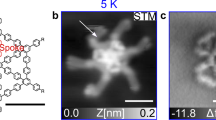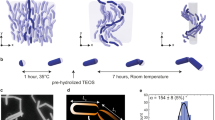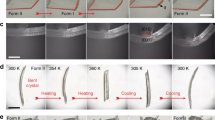Abstract
The optical, electronic and mechanical properties of synthetic and biological materials consisting of polymer chains depend sensitively on the conformation adopted by these chains. The range of conformations available to such systems has accordingly been of intense fundamental1,2 as well as practical3,4,5,6 interest, and distinct conformational classes have been predicted, depending on the stiffness of the polymer chains and the strength of attractive interactions between segments within a chain7,8,9,10. For example, flexible polymers should adopt highly disordered conformations resembling either a random coil or, in the presence of strong intrachain attractions, a so-called ‘molten globule’2,10. Stiff polymers with strong intrachain interactions, in contrast, are expected to collapse into conformations with long-range order, in the shape of toroids or rod-like structures8,9,11. Here we use computer simulations to show that the anisotropy distribution obtained from polarization spectroscopy measurements on individual poly[2-methoxy-5-(2′-ethylhexyl)oxy-1,4-phenylenevinylene] polymer molecules is consistent with this prototypical stiff conjugated polymer adopting a highly ordered, collapsed conformation that cannot be correlated with ideal toroid or rod structures. We find that the presence of so-called ‘tetrahedral chemical defects’, where conjugated carbon–carbon links are replaced by tetrahedral links, divides the polymer chain into structurally identifiable quasi-straight segments that allow the molecule to adopt cylindrical conformations. Indeed, highly ordered, cylindrical conformations may be a critical factor in dictating the extraordinary photophysical properties of conjugated polymers, including highly efficient intramolecular energy transfer and significant local optical anisotropy in thin films.
This is a preview of subscription content, access via your institution
Access options
Subscribe to this journal
Receive 51 print issues and online access
$199.00 per year
only $3.90 per issue
Buy this article
- Purchase on Springer Link
- Instant access to full article PDF
Prices may be subject to local taxes which are calculated during checkout



Similar content being viewed by others
References
de Gennes, P. -G. Scaling Concepts In Polymer Physics (Cornell Univ. Press, Ithaca, New York, 1979).
Grosberg, A. Y. & Kuznetsov, D. V. Quantitative theory of the globule-to-coil transition. Macromolecules 25, 1970–2003 (1992).
Friend, R. H. et al. Electroluminescence in conjugated polymers. Nature 397, 121–128 ( 1999).
Hide, F., Diazgarcia, M. A., Schwartz, B. J. & Heeger, A. J. New developments in the photonic applications of conjugated polymers. Acc. Chem. Res. 30, 430–436 (1997).
Yang, C. Y., Hide, F., Diazgarcia, M. A., Heeger, A. J. & Cao, Y. Microstructure of thin films of photoluminescent semiconducting polymers. Polymer 39, 2299 –2304 (1998).
Bloomfield, V. A. Condensation of DNA by multivalent cations: Consideration on mechanism. Biopolymers 31, 1471–1481 (1991).
Grosberg, A. Y. Certain possible conformational states of a uniform elastic polymer chain. Biophysics 24, 30–36 (1979).
Ivanov, V. A., Paul, W. & Binder, K. Finite chain length effects on the coil-globule transition of stiff-chain macromolecules—a Monte Carlo simulation. J. Chem. Phys. 109, 5659–5669 (1998).
Noguchi, H. & Yoshikawa, K. Morphological variation in a collapsed single homopolymer chain. J. Chem. Phys. 109, 5070–5077 (1998).
Zhou, Y. Q., Karplus, M., Wichert, J. M. & Hall, C. K. Equilibrium thermodynamics of homopolymers and clusters - molecular dynamics and Monte Carlo simulations of systems with square-well interactions. J. Chem. Phys. 107, 10691–10708 (1997).
Kuznetsov, Y. A. & Timoshenko, E. G. On the conformational structure of a stiff homopolymer. J. Chem. Phys. 111, 3744–3752 (1999).
Xie, X. S. & Trautman, J. K. Optical studies of single molecules at room temperature. Annu. Rev. Phys. Chem. 49, 441–480 (1998).
Basche, T., Moerner, W. E., Orrit, M. & Wild, U. P. (eds) Single Molecule Optical Detection, Imaging, and Spectroscopy (Verlag Chemie, Munich, 1996).
Ha, T., Laurence, T. A., Chemla, D. S. & Weiss, S. Polarization spectroscopy of single fluorescent molecules. J. Phys. Chem. B 103, 6839–6850 ( 1999).
Vandenbout, D. A. et al. Discrete intensity jumps and intramolecular electronic energy transfer in the spectroscopy of single conjugated polymer molecules. Science 277, 1074–1077 ( 1997).
Hu, D., Yu, J. & Barbara, P. F. Single-molecule spectroscopy of the conjugated polymer MEH-PPV. J. Am. Chem. Soc. 121, 6936 –6937 (1999).
Yaliraki, S. N. & Silbey, R. J. Conformational disorder of conjugated polymers—implications for optical properties. J. Chem. Phys. 104, 1245– 1253 (1996).
Gettinger, C. L., Heeger, A. J., Drake, J. M. & Pine, D. J. A photoluminescence study of poly(phenylene vinylene) derivatives—the effect of intrinsic persistence length. J. Chem. Phys. 101, 1673–1678 (1994).
Padmanaban, G. & Ramakrishnan, S. Conjugation length control in soluble poly[2-methoxy-5-((2′-ethylhexyl)oxy-1,4-phenylenevinylene] (MEHPPV): synthesis, optical properties, and energy migration. J. Am. Chem. Soc. 122, 2244–2251 (2000).
Mukamel, S., Tretiak, S., Wagersreiter, T. & Chernyak, V. Electronic coherence and collective optical excitations of conjugated molecules. Science 277, 781–787 (1997).
Woo, H. S. et al. Optical spectra and excitations in phenylene vinylene oligmers. Synth. Met. 59, 13–28 (1993).
Hagler, T. W., Pakbaz, K. & Heeger, A. J. Polarized-electroabsorption spectroscopy of a soluble derivative of poly(p-phenylenevinylene) oriented by gel processing in polyethylene—polarization anisotropy, the off-axis dipole moment, and excited-state delocalization. Phys. Rev. B 49, 10968– 10975 (1994).
Bassler, H. & Schweitzer, B. Site-selective fluorescence spectroscopy of conjugated polymer and oligomers. Acc. Chem. Res. 32, 173–182 (1999).
Blatchford, J. W. et al. Spatially and temporally resolved emission from aggregates in conjugated polymers. Phys. Rev. B 54, R3683–R3686 (1996).
Thulstrup, E. W. & Michl, J. Elementary Polarization Spectroscopy (VCH, New York, 1989).
Carmesin, I. & Kremer, K. The bond fluctuation method: a new effective algorithm for the dynamics of polymers in all spatial dimensions. Macromolecules 21, 2819– 2823 (1988).
Helfand, E. Theory of the kinetics of conformational transitions in polymer. J. Chem. Phys. 54, 4651–4661 (1971).
Orion, I., Buisson, J. P. & Lefrant, S. Spectroscopic studies of polaronic and bipolaronic species in n-doped poly(paraphenylenevinylene). Phys. Rev. B 57, 7050–7065 (1998).
Lodge, T. P. & Fredrickson, G. H. Optical anisotropy of tethered chains. Macromolecules 25, 5643– 5650 (1992).
Nguyen, T. Q., Doan, V. & Schwartz, B. J. Conjugated polymer aggregates in solution: Control of interchain interactions. J. Chem. Phys. 110, 4068–4078 (1999).
Acknowledgements
This work was supported by grants from the National Science Foundation (P.F.B.), the Robert A. Welch Foundation (P.J.R. & P.F.B.), and the Texas Advanced Research Program (P.J.R.). Further support was provided by the Institute for Theoretical Chemistry and by the Laboratory for Spectroscopic Imaging, University of Texas. We also thank A. Yethiraj for discussions.
Author information
Authors and Affiliations
Corresponding author
Rights and permissions
About this article
Cite this article
Hu, D., Yu, J., Wong, K. et al. Collapse of stiff conjugated polymers with chemical defects into ordered, cylindrical conformations. Nature 405, 1030–1033 (2000). https://doi.org/10.1038/35016520
Received:
Accepted:
Issue Date:
DOI: https://doi.org/10.1038/35016520
This article is cited by
-
Aggregates of conjugated polymers: bottom-up control of mesoscopic morphology and photophysics
NPG Asia Materials (2023)
-
Surface enrichment structures in a binary polymer system with different stiffnesses confined in slits
Colloid and Polymer Science (2023)
-
Nanoscale π-conjugated ladders
Nature Communications (2021)
-
Stereoselective gridization and polygridization with centrosymmetric molecular packing
Nature Communications (2020)
-
Impact of Local Stiffness on Entropy Driven Microscopic Dynamics of Polythiophene
Scientific Reports (2020)
Comments
By submitting a comment you agree to abide by our Terms and Community Guidelines. If you find something abusive or that does not comply with our terms or guidelines please flag it as inappropriate.



